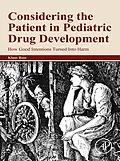Considering the Patient in Pediatric Drug Development: How Good Intentions Turned into Harm addresses a fundamental challenge in drug development and healthcare for young patients. In clinical trials and clinical practice, the term "children" is used ambiguously to confer physiological characteristics to a chronological age limit, which in reality does not exist. This book outlines why the United States (US) and European Union's (EU) regulatory authorities, pediatric academia, and the pharmaceutical industry demand, support and perform pediatric drug studies, along with the key flaws of this demand that blurs the different administrative and physiological meanings of the term "child." In addition, the book covers why most pediatric regulatory studies lack medical sense and many even harm young patients and the conflicts of interest behind pediatric drug studies. It includes relevant information about the maturation of the human body regarding absorption, distribution, metabolism and excretion of food and drugs as well as key differences between newborns, infants, older children and adolescents. - Explains relevant information about the maturation of the human body regarding absorption, distribution, metabolism and excretion of food and drugs, including key differences between newborns, infants, older children and adolescents - Discusses historical roots of separate drug approval in officially labeled "children" and conflicts of interest in performing and publishing "pediatric" research - Helps to decipher justifications for pediatric studies to help people navigate the relevance of the information
Autorentext
Klaus Rose studied psychology, Latin languages and medicine. He was Global Head Pediatrics of Novartis 2001 - 2005 and of Genentech/Roche 2005 - 2009 (both large international pharmaceutical companies) and is independent since 2011. He publishes in international peer-reviewed journals and has co-edited three textbooks on pediatric drug development.
Inhalt
Rumpelstiltskin and the miller's daughter
Conclusion and outlook
Introduction
Abbreviations and technical explanations
Background
1. The process of modern drug development and the challenge of young patients
2. US and EU pediatric legislation
3. A paradigm shift
4. Introduction: specific disease areas
4.1 Tissue-engineered products (TEPs), advanced medicinal
4.2 Suicide, depression, and mental disorders in young
4.3 Cancer and malignancies in young patients
4.4 Chronic arthritis in young and adult patients, and "Juvenile Idiopathic Arthritis (JIA)
4.5 Diabetes
4.6 Allergies and allergen-specific immunotherapy (ASIT) in young patients
4.7 Epilepsy
4.8 Multiple sclerosis
4.9 Atopic dermatitis and psoriasis
4.10 Cystic fibrosis
4.11 Vaccines and antiinfectives
5. Neonatology
6. Challenges at the interface of science, drug development, and drug approval beyond specific disease areas
6.1 The on-label/off-label framework in adults and young patients
6.2 Developmental pharmacology and the globalization of the children-are-therapeutic-orphans mantra
6.3 Extrapolation
6.4 Daily deceit in "pediatric studies
6.5 Myths in today's medical world and "pediatric studies
7. Juvenile animal studies
8. Child-friendly formulations: tablets, quick-dissolving formulations, liquids, and more
9. What do young patients really need?
